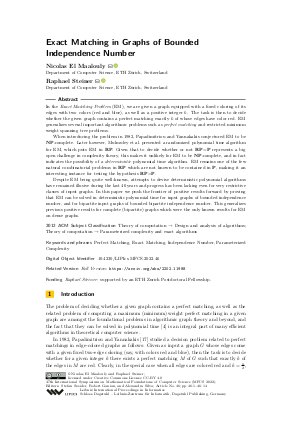Exact Matching in Graphs of Bounded Independence Number
Authors
Nicolas El Maalouly  ,
Raphael Steiner
,
Raphael Steiner 
-
Part of:
Volume:
47th International Symposium on Mathematical Foundations of Computer Science (MFCS 2022)
Part of: Series: Leibniz International Proceedings in Informatics (LIPIcs)
Part of: Conference: Mathematical Foundations of Computer Science (MFCS) - License:
 Creative Commons Attribution 4.0 International license
Creative Commons Attribution 4.0 International license
- Publication Date: 2022-08-22
File

PDF
LIPIcs.MFCS.2022.46.pdf
- Filesize: 0.88 MB
- 14 pages
Document Identifiers
Related Versions
- Full Version https://arxiv.org/abs/2202.11988
Subject Classification
ACM Subject Classification
- Theory of computation → Design and analysis of algorithms
- Theory of computation → Parameterized complexity and exact algorithms
Keywords
- Perfect Matching
- Exact Matching
- Independence Number
- Parameterized Complexity
Metrics
- Access Statistics
-
Total Accesses (updated on a weekly basis)
0PDF Downloads0Metadata Views
Abstract
In the Exact Matching Problem (EM), we are given a graph equipped with a fixed coloring of its edges with two colors (red and blue), as well as a positive integer k. The task is then to decide whether the given graph contains a perfect matching exactly k of whose edges have color red. EM generalizes several important algorithmic problems such as perfect matching and restricted minimum weight spanning tree problems. When introducing the problem in 1982, Papadimitriou and Yannakakis conjectured EM to be NP-complete. Later however, Mulmuley et al. presented a randomized polynomial time algorithm for EM, which puts EM in RP. Given that to decide whether or not RP=P represents a big open challenge in complexity theory, this makes it unlikely for EM to be NP-complete, and in fact indicates the possibility of a deterministic polynomial time algorithm. EM remains one of the few natural combinatorial problems in RP which are not known to be contained in P, making it an interesting instance for testing the hypothesis RP=P. Despite EM being quite well-known, attempts to devise deterministic polynomial algorithms have remained illusive during the last 40 years and progress has been lacking even for very restrictive classes of input graphs. In this paper we push the frontier of positive results forward by proving that EM can be solved in deterministic polynomial time for input graphs of bounded independence number, and for bipartite input graphs of bounded bipartite independence number. This generalizes previous positive results for complete (bipartite) graphs which were the only known results for EM on dense graphs.
Cite As Get BibTex
Nicolas El Maalouly and Raphael Steiner. Exact Matching in Graphs of Bounded Independence Number. In 47th International Symposium on Mathematical Foundations of Computer Science (MFCS 2022). Leibniz International Proceedings in Informatics (LIPIcs), Volume 241, pp. 46:1-46:14, Schloss Dagstuhl – Leibniz-Zentrum für Informatik (2022)
https://doi.org/10.4230/LIPIcs.MFCS.2022.46
BibTex
@InProceedings{elmaalouly_et_al:LIPIcs.MFCS.2022.46,
author = {El Maalouly, Nicolas and Steiner, Raphael},
title = {{Exact Matching in Graphs of Bounded Independence Number}},
booktitle = {47th International Symposium on Mathematical Foundations of Computer Science (MFCS 2022)},
pages = {46:1--46:14},
series = {Leibniz International Proceedings in Informatics (LIPIcs)},
ISBN = {978-3-95977-256-3},
ISSN = {1868-8969},
year = {2022},
volume = {241},
editor = {Szeider, Stefan and Ganian, Robert and Silva, Alexandra},
publisher = {Schloss Dagstuhl -- Leibniz-Zentrum f{\"u}r Informatik},
address = {Dagstuhl, Germany},
URL = {https://drops.dagstuhl.de/entities/document/10.4230/LIPIcs.MFCS.2022.46},
URN = {urn:nbn:de:0030-drops-168447},
doi = {10.4230/LIPIcs.MFCS.2022.46},
annote = {Keywords: Perfect Matching, Exact Matching, Independence Number, Parameterized Complexity}
}
Author Details
Funding
- Steiner, Raphael: supported by an ETH Zurich Postdoctoral Fellowship.
References
-
André Berger, Vincenzo Bonifaci, Fabrizio Grandoni, and Guido Schäfer. Budgeted matching and budgeted matroid intersection via the gasoline puzzle. Mathematical Programming, 128(1):355-372, 2011.

-
Bruno Courcelle. The monadic second-order logic of graphs. I. Recognizable sets of finite graphs. Information and Computation, 85(1):12-75, 1990.

-
Norman Do. Party problems and ramsey theory. Vinculum, 56(2):18-19, 2019.

-
Jack Edmonds. Paths, trees, and flowers. Canadian Journal of Mathematics, 17:449-467, 1965.

-
Anna Galluccio and Martin Loebl. On the theory of Pfaffian orientations. I. Perfect matchings and permanents. Electronic Journal of Combinatorics, 6:R6, 1999.

- Hans-Florian Geerdes and Jácint Szabó. A unified proof for karzanov’s exact matching theorem. Technical Report QP-2011-02, Egerváry Research Group, Budapest, 2011. URL: https://egres.elte.hu/.
- Fabrizio Grandoni and Rico Zenklusen. Optimization with more than one budget. arXiv preprint, 2010. URL: http://arxiv.org/abs/1002.2147.
-
Rohit Gurjar, Arpita Korwar, Jochen Messner, Simon Straub, and Thomas Thierauf. Planarizing gadgets for perfect matching do not exist. In International Symposium on Mathematical Foundations of Computer Science, pages 478-490. Springer, 2012.

-
Rohit Gurjar, Arpita Korwar, Jochen Messner, and Thomas Thierauf. Exact perfect matching in complete graphs. ACM Transactions on Computation Theory (TOCT), 9(2):1-20, 2017.

-
AV Karzanov. Maximum matching of given weight in complete and complete bipartite graphs. Cybernetics, 23(1):8-13, 1987.

-
Pieter W Kasteleyn. Graph theory and crystal physics. Harary, F. (ed.), Graph Theory and Theoretical Physics, pages 43-110, 1967.

-
Joseph B Kruskal. Paths, trees, and flowers. Proceedings of the American Mathematical Society, 7:48-50, 1956.

-
Charles H C Little. Kasteleyn’s theorem and arbitrary graphs. Canadian Journal of Mathematics, 25(4):758-764, 1973.

-
Monaldo Mastrolilli and Georgios Stamoulis. Constrained matching problems in bipartite graphs. In International Symposium on Combinatorial Optimization, pages 344-355. Springer, 2012.

-
Monaldo Mastrolilli and Georgios Stamoulis. Bi-criteria and approximation algorithms for restricted matchings. Theoretical Computer Science, 540:115-132, 2014.

-
Ketan Mulmuley, Umesh V Vazirani, and Vijay V Vazirani. Matching is as easy as matrix inversion. Combinatorica, 7(1):105-113, 1987.

-
Christos H Papadimitriou and Mihalis Yannakakis. The complexity of restricted spanning tree problems. Journal of the ACM (JACM), 29(2):285-309, 1982.

-
Georgios Stamoulis. Approximation algorithms for bounded color matchings via convex decompositions. In International Symposium on Mathematical Foundations of Computer Science, pages 625-636. Springer, 2014.

-
Ola Svensson and Jakub Tarnawski. The matching problem in general graphs is in quasi-nc. In 2017 IEEE 58th Annual Symposium on Foundations of Computer Science (FOCS), pages 696-707. Ieee, 2017.

-
Tongnyoul Yi, Katta G Murty, and Cosimo Spera. Matchings in colored bipartite networks. Discrete Applied Mathematics, 121(1-3):261-277, 2002.

-
Raphael Yuster. Almost exact matchings. Algorithmica, 63(1):39-50, 2012.

